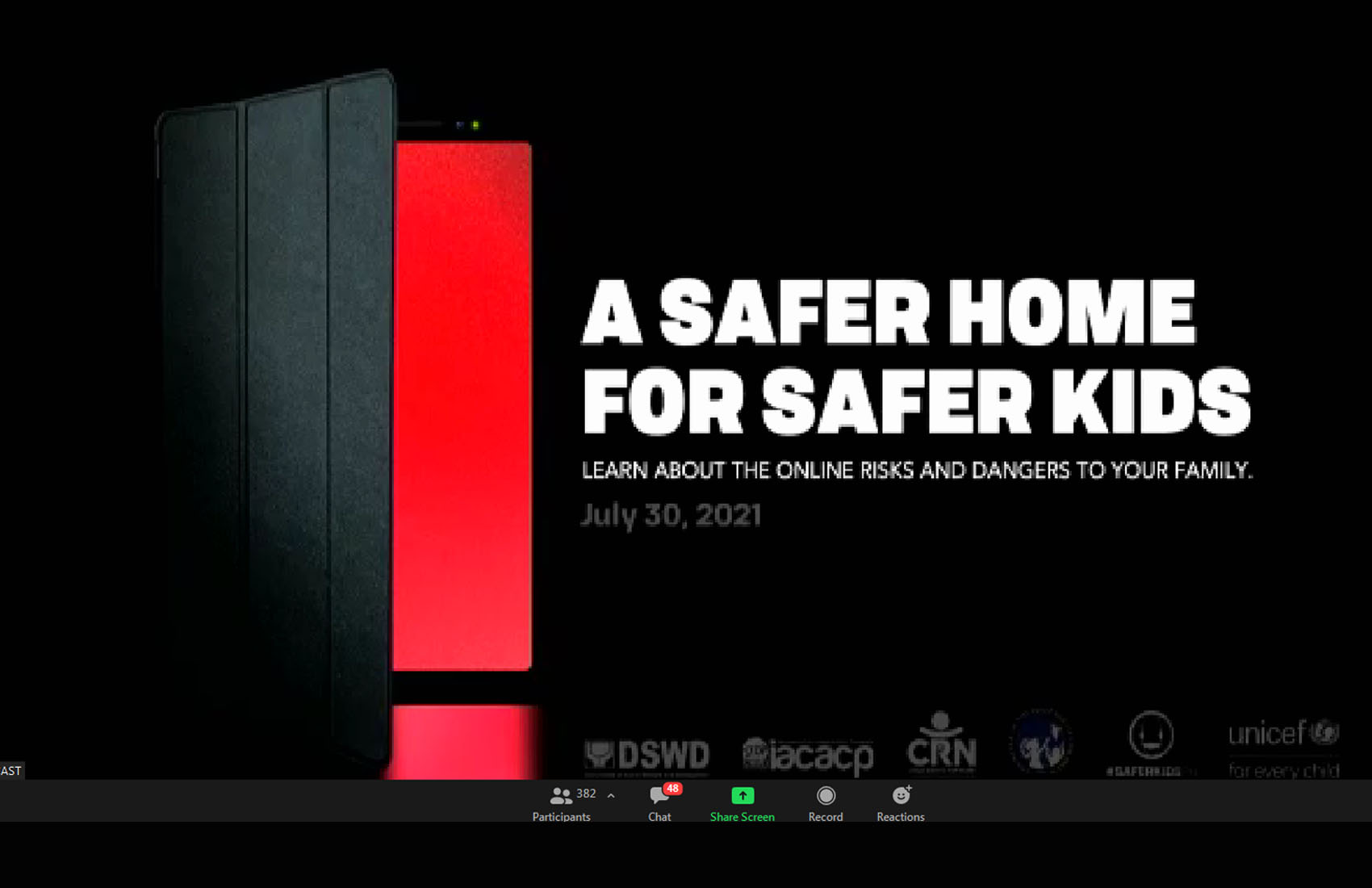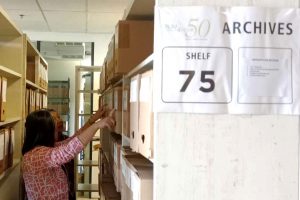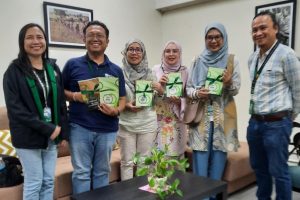PKOLS and OSAEC Projects Featured in Safer Kids Event
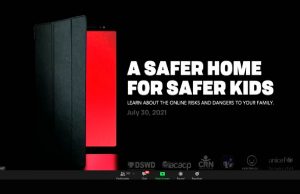 How dangerous has the pandemic been for Philippine children?
How dangerous has the pandemic been for Philippine children?
Exceedingly, if one is to ask advocates of child protection against online abuse. Beyond the threat posed by COVID-19 to children who cannot as yet be vaccinated, staying within the confines of the home has led to more immediate risks of physical abuse instead of being an effective health protocol.
UNICEF Philippines Deputy Representative Behzad Noubary cited alarming figures on the effects of quarantine from the agency’s 2020 data. During the “A Safer Home for Safer Kids” Zoom Live event held on July 30, he shared that 1 in 2 children are victims of online violence in the country. Moreover, the pandemic resulted in a 209% rise in cybercrimes against children. For this reason, he underscored the importance of research that has been conducted such as SDRC’s Philippine Kids Online Survey (PKOLS) and the National Study on Online Sexual Abuse and Exploitation of Children (OSAEC) in the Philippines, which “now more than ever are very relevant and strive to achieve a whole-of-society approach” to protecting the young from the dangers of a rapidly expanding internet.
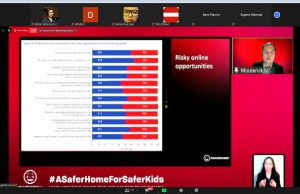 The project leaders for both studies were on hand to discuss their findings and recommendations for the benefit of viewers. DLSU College of Liberal Arts Dean and PKOLS principal investigator Dr. Rhoderick Nuncio introduced the survey as seeking to provide a demographic of Filipino Internet users between the ages of 9 and 17, how they access the Internet and what their level of digital skills is; to establish the rate of prevalence of online abuse that child users experience; and to identify their safety practices and how their parents mediate in their Internet use. He discussed the survey findings with regard to where and how children go online, the length of time they spend online, sexual content found online and their experiences of unwanted sexual contact, Internet addiction, experiences of bullying, and the benefits and risks of children’s self-awareness.
The project leaders for both studies were on hand to discuss their findings and recommendations for the benefit of viewers. DLSU College of Liberal Arts Dean and PKOLS principal investigator Dr. Rhoderick Nuncio introduced the survey as seeking to provide a demographic of Filipino Internet users between the ages of 9 and 17, how they access the Internet and what their level of digital skills is; to establish the rate of prevalence of online abuse that child users experience; and to identify their safety practices and how their parents mediate in their Internet use. He discussed the survey findings with regard to where and how children go online, the length of time they spend online, sexual content found online and their experiences of unwanted sexual contact, Internet addiction, experiences of bullying, and the benefits and risks of children’s self-awareness.
CLA Behavioral Sciences Department Chair and PKOLS co-investigator Dr. Myla Arcinas further presented the survey’s findings with regard to children’s negative online experiences and help-seeking behavior. Through graphics, she illustrated how mediation on the part of parents, the school and teachers, and peers could help address the harm done through OSAEC. She concluded by expounding on the team’s recommendations with regard to policy (including the formulation of a national information and communication technology (ICT) policy for education, the establishment of an e-learning outreach program in select barangays, and enhancing the regulation and accountability of PISONET cafes to make them child-friendly) and programs (including the 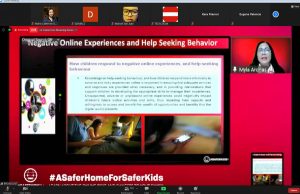 incorporation of digital citizenship and online safety into parenting support programs, the identification of high-risk communities and populations for caregivers’ and parents’ digital literacy training, and investing in school and community-based evidence-informed peer and bystander support intervention).
incorporation of digital citizenship and online safety into parenting support programs, the identification of high-risk communities and populations for caregivers’ and parents’ digital literacy training, and investing in school and community-based evidence-informed peer and bystander support intervention).
For the National Study on OSAEC, CLA Psychology Department associate professor and project principal investigator Dr. Maria Caridad Tarroja explained that the project traced the phenomenon of online sexual abuse and exploitation in the Philippines from the child’s exposure and rescue, to the reporting and prosecution of cases, and the intervention provided to the child. She focused on the impact that OSAEC has on the child in terms of the rescue (involving separation from the family, emotional attachment to the perpetrator, and a consequent sense of shame), of life in the shelter, of the ensuing trial and investigation (particularly with respect to the disclosure issues of trauma, trust, and accuracy of account; the mixed emotions stemming from the proceedings; and the effect on the child’s sense of safety and control), and the resulting view of the world that the child develops.
Dr. Tarroja concluded with the team’s recommendations regarding the family and community (in terms of parental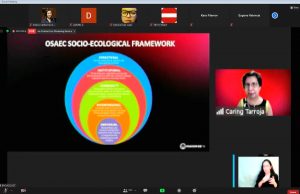 education, community awareness, and the inclusion of online education in the school curriculum); the child victim (in terms of reducing their involvement in court proceedings, protecting them from media coverage of OSAEC cases, strengthening services in halfway homes, and providing appropriate psychosocial interventions); and the responders, service providers and private sector (in terms of providing debriefing and regular psychosocial processing). The team also recommended that UNICEF (which commissioned both the OSAEC and PIKOLS projects) continue to take the lead in engaging stakeholders, experts and the public to find concrete ways of preventing, minimizing, and addressing the problems brought about by OSAEC.
education, community awareness, and the inclusion of online education in the school curriculum); the child victim (in terms of reducing their involvement in court proceedings, protecting them from media coverage of OSAEC cases, strengthening services in halfway homes, and providing appropriate psychosocial interventions); and the responders, service providers and private sector (in terms of providing debriefing and regular psychosocial processing). The team also recommended that UNICEF (which commissioned both the OSAEC and PIKOLS projects) continue to take the lead in engaging stakeholders, experts and the public to find concrete ways of preventing, minimizing, and addressing the problems brought about by OSAEC.
After the presentations, participants in the online event were assigned to break-out rooms to discuss their thoughts on how to contribute to eradicating OSAEC among Philippine children. ABS-CBN news correspondent Jing Castañeda provided a synthesis for her group’s discussion, saying that efforts could be made at the family level (by revisiting parenting styles and forging stronger communication between them and their children), at the institutional level (by incorporating online safety into the curriculum and training children as well as parents in the area of digital knowledge), and at the community level (where citizens can write to their congressmen, and can campaign for the passage of the Bill advocating against child abuse).
Her group’s recommendations were supported by Child Rights Network Representative Glaiza Norico, who pointed out that there is a tendency for children to fear talking about their experiences because cultural and social norms teach them to keep quiet, even in their own homes. She relayed the suggestions of her own group that materials on OSAEC (such as videos) need to be child-friendly in order to truly benefit and protect the youth. Ultimately, in order to help OSAEC victims, the planning and execution of activities and programs should always involve children.
Viewers on the Facebook Live stream were from elementary and secondary schools in Ozamiz City, Pangasinan, Negros Occidental, Cagayan de Oro City, Sorsogon, the Mindanao Children’s Ministries Network, Kaisaka, Inc., and the Zambales Police Provincial Office in Masinloc.
SaferKidsPH is an Australian Government initiative delivered through a consortium of Save the Children Philippines, the Asia Foundation and UNICEF to reduce the online sexual abuse and exploitation of children in the Philippines. The July 30 Zoom Live event was part of a ten-day series of activities to commemorate the World Day against Trafficking in Persons.


